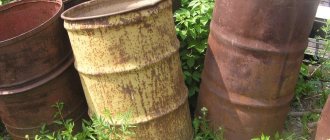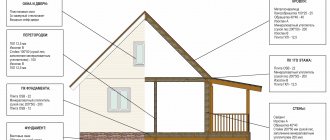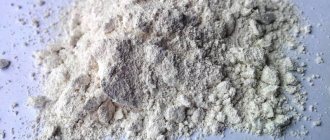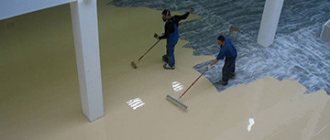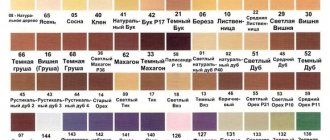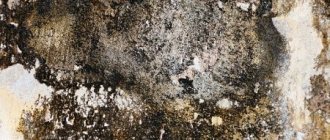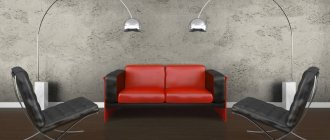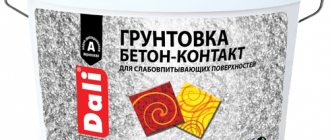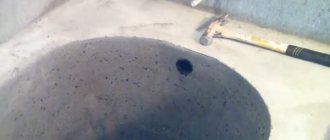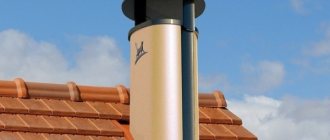Concrete is a very durable material. It copes well with adverse weather conditions and high loads. But concrete is not able to resist such a destruction process as surface abrasion, which results in the formation of cement dust on the floor surface. To combat this phenomenon, special impregnating compounds are used.
Why protect concrete?
The main disadvantage inherent in concrete is its susceptibility to environmental influences and its relatively short service life in the open air or in aggressive environments without the use of protective agents and proper finishing. Without proper care, this material loses its strength over time and becomes brittle - it can crack and chip, compromising the integrity of the structure of which it is the basis.
To build external structures made of concrete, it is necessary to choose the right class of concrete and select the optimal protective coating based on the construction site and its purpose. Thus, it is possible to increase resistance to mechanical and natural influences and extend the service life of products made from this material by an order of magnitude.
Waterproofing concrete with “liquid glass”
Liquid glass is a substance that is a mixture of sodium and potassium silicates. The composition of liquid glass is similar to stationery glue. The silicates that make up liquid glass react with concrete components and plug microcracks in layers close to the surface.
Liquid glass is a penetrating waterproofing material. Application is very simple - using a brush or roller. You can do the work yourself. But, it should be noted that the composition is fragile after drying, so such waterproofing requires protection from mechanical damage.
Waterproofing concrete with “liquid glass”
In principle, when using high quality cement mortar and high inherent strength, as well as creating certain molding and drying conditions, it is possible to obtain practically waterproof concrete. This type of concrete is used in the construction of high-rise buildings and special-purpose structures. Under normal conditions, making such concrete is very difficult. Especially when it comes to low-rise private construction.
To increase the service life of buildings and to reduce the impact of moisture on them, waterproofing of concrete is necessary. A variety of materials can be used for this: concrete sealant; hydrophobic additives for concrete; mastic for concrete; welded or glued rolls. The main thing is that the waterproofing is selected appropriately, and the treatment is done professionally.
Types of protection of concrete from destruction on the street - what are there and which one to choose
There are only two methods of corrosion protection for concrete and reinforced concrete structures - Primary and secondary (SP 28.13330-2012)
5.1.1 Primary protection measures for concrete and reinforced concrete structures include:
- the use of concrete that is resistant to aggressive environments, which is ensured by the choice of cement and aggregates, the selection of concrete composition, reducing the permeability of concrete, the use of compacting, air-entraining and other additives that increase the durability of concrete in an aggressive environment and the protective effect of concrete in relation to steel reinforcement and steel embedded parts parts and connecting elements;
- selection and use of fittings that correspond to operating conditions in terms of corrosion characteristics;
- protection against corrosion of embedded parts and connections at the stage of manufacturing and installation of prefabricated reinforced concrete structures, protection of prestressed reinforcement in the channels of structures manufactured with subsequent tension of the reinforcement on concrete;
- compliance with additional design and design requirements when designing concrete and reinforced concrete structures, including ensuring the design thickness of the protective layer of concrete and limiting the width of cracks, etc.
5.1.2 Secondary protection measures include protection of the surface of concrete and reinforced concrete structures:
- paint and varnish coatings, including thick-layer (mastic) coatings;
- adhesive insulation;
- coating and plaster coatings;
- cladding with piece or block products;
- sealing impregnation of the surface layer of structures with chemically resistant materials;
- treating the concrete surface with penetrating compounds with compaction
- porous structure of concrete with crystallizing new formations;
- treatment with water-repellent compounds;
- treatment with drugs - biocides, antiseptics, etc.
Secondary protection against corrosion of concrete and reinforced concrete structures is used if primary protection is not enough and this may occur during the construction process or at the stage of repair of concrete structures. These are special materials (impregnations, roll and sheet materials) that are applied to the already hardened concrete surface. They are able to improve the performance characteristics of concrete structures, enhancing their ability to resist water, chemical, temperature and mechanical influences.
Components are added to the concrete mixture that increase strength, resistance to temperature changes, chemical elements, water resistance and corrosion resistance.
Find out everything about impregnations for concrete: Water-repellent impregnations as mandatory protection for concrete structures.
Functions of impregnating compositions
Concrete is porous, and its strength characteristics are largely determined by the process of cement hydration. Due to the technological features of manufacturing, the pores of concrete contain a gel component of cement, moisture and air. These elements negatively affect the properties of structures made of concrete.
Due to the presence of microscopic pores, concrete has two disadvantages:
- slight hydrophobicity, as moisture penetrates through the pores,
- low density of the material, which reduces its strength.
At the modern technological stage, it has become possible to change the porous structure of concrete to a waterproof one. This is done using impregnations.
The use of impregnations allows you to solve the following problems:
- protection from aggressive chemical substances and the environment,
- increasing the strength of the material,
- increased wear resistance,
- no dust formation on the surface due to crumbling of the material,
- strengthening old structures,
- extending the service life of concrete products,
- more attractive appearance of concrete surfaces.
Water-repellent compounds are used for treating concrete at the following facilities:
- exhibition complexes and retail premises,
- warehouses,
- car service workshops, car washes, car parks,
- open spaces with concrete surfaces,
- livestock farms,
- industrial enterprises,
- administrative and residential buildings.
Note! Depending on the scope of application, the composition of impregnations may differ significantly.
Why does concrete deteriorate and what exactly does it need to be protected from?
5.2 Degree of aggressive media
5.2.1 Depending on the physical state, aggressive media are divided into gaseous, liquid and solid. Depending on the intensity of the aggressive impact on concrete and reinforced concrete structures, environments are divided into non-aggressive, slightly aggressive, moderately aggressive and highly aggressive. Depending on the nature of the impact of aggressive media on concrete, media are divided into chemical (for example, sulfate, magnesium, acid, alkaline, etc.) and biologically active (for example, the chemical effect of metabolic products of fungi, bacteria, physical and mechanical effects of plant roots, fungal hyphae, fouling by algae, lichens, etc.).
5.2.2 Depending on the conditions of exposure to aggressive media on concrete, media are divided into classes, which are determined in relation to specific concrete and reinforced concrete unprotected from corrosion. Classes of media indicating their indices in increasing aggressiveness are shown in Table A.1.
5.2.3 When simultaneously exposed to aggressive environments with different indices, but of the same class, the requirements relating to the environment with a higher index are applied (unless otherwise specified in the project).
5.2.4 Classification of operating environments and the degree of aggressive influence of environments on structures made of concrete and reinforced concrete are given in Appendices A, B, C and D:
- gaseous media - tables A.1, B.1, B.2;
- solid media - tables A.1, B.3, B.4, C.1, C.2;
- soils above the groundwater level - tables A.1, B.1, B.2;
- liquid inorganic media - tables A.1, B.3, B.4, B.5, D.2;
- chlorides - tables A.1, B.3, B.4, C.2, C.3, D.2;
- liquid organic media - tables A.1, B.6;
- biologically active media - table B.7.
Functional properties of impregnations
Depending on the functionality, concrete impregnations are divided into:
- strengthening;
- water-repellent;
- dust removal;
- coloring.
Strengthening impregnations
Impregnations of this type are in most cases made on the basis of inorganic compounds - silicate primer compositions. They do not form a protective layer on the surface of concrete, since they penetrate deep into the material and change its structure. Thanks to this property, the impregnation does not peel off and provides the concrete surface with high wear resistance and complete dust removal.
Previously, deep penetration impregnations were made on the basis of sodium and potassium silicates. Now they have been replaced by new compositions based on lithium silicates. When using lithium impregnations, the possibility of efflorescence on concrete is eliminated. Concrete floors treated with such impregnations become highly resistant to mechanical abrasion and moisture, and also stop generating dust. Deep impregnation increases the strength of the surface layer of concrete by 2-3 times.
Water-repellent impregnations
Water-repellent (water-repellent) impregnations penetrate into the pores and cracks of concrete, protecting it from moisture penetration and the effects of such negative factors as:
- microorganisms, mold, fungi;
- salt/acid precipitation;
- UV rays;
- formation of efflorescence.
Water-repellent impregnations increase the frost resistance of concrete structures used outdoors. They also protect indoor structures from moisture, but do not protect the foundation from the penetration of groundwater. This problem is solved using a whole range of measures to waterproof a concrete structure.
Impregnations of this type are presented on the construction market in a very wide range. The most effective and expensive are two-component compositions used for treating hydraulic structures, such as swimming pools. This type of impregnation can essentially be called universal, but if concrete does not need such a set of qualities, then it is better to purchase specialized impregnation compositions, which are cheaper and do an excellent job with the assigned tasks.
Dust-removing impregnations
Impregnations of this type are widely used for exposed concrete floors that undergo heavy loads, as well as for protecting outdoor areas. Such a wide scope of application is due to the properties of impregnations, which, in addition to dust removal, also provide high wear resistance and strength of concrete surfaces.
Anti-dust compounds are used for the following purposes:
- preventing dust formation;
- increasing wear resistance and extending the service life of concrete surfaces;
- protecting the concrete floor from destruction, exposure to acids, alkalis and oils;
- making it easier to maintain concrete floors.
Coloring compounds
Concrete can be painted with regular paint or with a special colored impregnation. Painted surfaces are less durable. With constant traffic/traffic loads, the paint layer cracks and peels off.
Colored impregnations penetrate deep into concrete up to 3 millimeters, due to which the color of the floor is preserved for a long time, regardless of the intensity of exposure to various loads. But the concrete surface treated with a coloring composition must be additionally coated with a protective water-repellent impregnation.
How to choose the best protective coating for concrete?
The answer to this question depends on what stage the construction is at, in what region the object is located and what kind of protection needs to be done against what kind of aggression.
The best solution at the pre-construction stage would be to combine a suitable concrete composition and protective types of coatings.
If concrete with characteristics that do not ensure the resistance of the structure to aggressive environmental influences is used during construction, then in addition to primary protection measures, measures for secondary protection of the structure are provided in accordance with the requirements of SP 28.13330.2012
During the reconstruction stages, only secondary protection measures can be used. The most universal option would be coating or painting insulation (a combination of impregnating primer and paint).
The best option in terms of price-quality ratio under moderate loads and the absence of strong temperature changes would be a combination of primer and roofing felt.
If you need an option to protect concrete under special conditions - for example, with constant contact with water or chemically active substances, we recommend selecting a protective agent in accordance with the standards, based on the characteristics of the concrete structure and the aggressiveness of the environment. Below we will describe all these tools in detail.
Conclusion
Protecting concrete is quite an important and painstaking job, without which the concrete base will quickly deteriorate. In summer, it is important to carry out moisturizing procedures, and in winter, to use methods that can preserve the structure from exposure to low temperatures.
Information sources:
- [Textbook]: L.I. Dvorkin - Practical methodology for designing concrete composition.
- [Textbook]: A.G. Zotkin - Concrete and concrete structures.
- [Textbook]: E.I. Batyanovsky - Technology and methods of winter monolithic and on-site concreting.
Means for primary protection of concrete
Plasticizers, which include lingosulfonate, prevent degradation of the concrete structure under the influence of the external environment and perfectly increase the resistance of the material to mechanical loads. They are used to counteract sulfates, which are successfully neutralized and can no longer destroy the concrete structure from the inside.
Mineral additives, which include silicon, increase the strength of concrete, and electrolytic modifiers increase the rate of concrete hardening. They are often used to build foundations for residential buildings.
There are also additives of combined action that can improve several properties of concrete at once - for example, increase strength and protect metal reinforcement from rust.
Important : all products of this class are added to the concrete mixture at the stage of preparing the concrete mixture.
Features of the foundation arrangement
Carrying out concrete work outside premises requires that the object be located on open ground. When constructing a blind area, platform for cars, or other structures, it is necessary to properly prepare the foundation.
The presence of moderate or strong dynamic loads on the surface structures of the material, along with the influence of external environmental factors, worsens the technical and operational properties of concrete, and the material itself quickly deteriorates. In addition to preparing a high-quality mixture for concrete work and using external impregnations, additional attention should be paid to arranging the base under the structure.
Typical layer structure:
- Treated and compacted soil;
- Sand bedding;
- Crushed stone bedding;
- Main concrete layer.
If necessary (for example, for a blind area), geotextiles are placed in the gaps between the fine-grained and coarse-grained aggregates, and the base soil is covered with waterproofing.
Secondary protection of concrete and reinforced concrete structures
Primers
Primers are rarely used as a finishing material. Most often, they act as an internal link between the concrete and the protective coating. Penetrating primers help fill the pores in concrete, significantly enhancing its strength and increasing the overall effectiveness of moisture protection with roll or coating materials.
Another advantage when working with primers is the absence of joints and seams, making them ideal for treating large areas, providing complete surface protection. In addition, they bind all dust from the concrete, creating optimal conditions for applying a layer of protective coating. Primers are extremely easy to use - a regular paint roller will be enough to apply them, which allows you to use these materials without having professional construction skills.
Mastics
Mastics, like primers, usually form the primary or secondary layer in an insulation system. They are based on polymers and bitumen, the former are more effective in terms of resistance to temperature fluctuations and complete waterproofness, while bitumen analogues are not as effective against ultraviolet radiation and temperature changes, but significantly benefit in price. Among the undeniable advantages of using mastics, it is worth noting ideal adhesion to concrete at a relatively low price and the possibility of self-application using a roller.
Important: bitumen mastics are not recommended for use in hot climates - they can melt and lose their adhesive properties, compromising the strength and integrity of the insulating structure.
Liquid rubber
Liquid rubber combines high strength and elasticity, due to which it provides high-quality protection from water, temperature changes and mechanical damage under moderate load. The beautiful structure and large selection of colors allow this material to be used as a finishing coating.
Liquid rubber has only one significant drawback, which is the complex process of its preparation and application. You need to use special painting tools in the form of spray guns or use the pouring method to cover the concrete with it. In addition, it is necessary to monitor the thickness of the rubber layer, since if applied unevenly, its performance characteristics may deteriorate, making its independent use very difficult.
Membranes
Membranes are an ideal solution for protecting concrete roofs and objects that rarely come into contact with household chemicals. Strong and durable, they perform not only a protective, but also an insulating function. For cold climates, it is best to choose an EPDM membrane, which contains rubber and has excellent frost resistance.
The membranes are laid by soldering using construction torches, which requires special knowledge and experience, so it will be difficult to install them yourself. The disadvantages include the high price, but it is justified by the long period of operation and excellent performance of this material.
Important: all membranes are extremely sensitive to chemicals - gasoline, diesel fuel and even car oil can seriously damage this material.
Bitumen roll materials
Bitumen roll materials can serve for a very long time, maintaining excellent resistance to moisture, fire and chemical elements throughout the entire period of operation. At the same time, they have a high degree of resistance to mechanical damage. Among the disadvantages, it is worth noting the large consumption of material for joining seams (10 centimeters or more), as well as the complex installation procedure. Bitumen roll materials are installed using special construction burners, and therefore their installation requires special skills.
Important: for long-term operation, it is critical to buy bitumen roll materials based on polyester or fiberglass. If the composition contains fiberglass, then the material is suitable only as a temporary solution.
Ruberoid
Ruberoid is one of the most popular solutions with the best price-quality ratio. This is an inexpensive material that, paired with a good penetrating primer or mastic, will provide excellent protection against moisture, mechanical damage and corrosion.
The disadvantages include high consumption (to achieve the optimal effect, you need to lay at least two layers of roofing material) and an inconvenient installation procedure - bitumen is used to glue the sheets.
Pasting protective film
This material is ideal for protecting concrete from water and high humidity. It provides excellent waterproofing and is widely used in cases where the concrete is constantly exposed to water or when construction is carried out in marshy areas saturated with water. Most often used for gluing the bases of concrete structures.
The main disadvantage of such coatings is the lack of strength, but this is offset by the low price.
Paint coatings
Varnishes and paints are widely used as a finishing treatment for concrete in conditions of moderate humidity and low mechanical loads. A low price and a huge number of colors make these concrete protectants one of the most popular for treating yard structures and homes.
Before using them, it is necessary to use concrete impregnations, which will fill the pores, destroy all biological organisms and make the treated surface perfectly smooth.
The main disadvantages of these materials include a relatively short service life and low strength.
Roll and sheet waterproofing
Protection of concrete structures of this type is very limited in application. Thus, it is not used if it is necessary to protect against destruction of the coating of concrete paths on the street due to the lack of resistance to mechanical stress. However, this method is almost the best option if it is necessary to protect roofs, foundations, plinths and other non-load-bearing concrete surfaces.
This type of protection includes the following materials:
- roofing material, which is glued to bitumen mastic in several layers;
- EPDM membranes, the process of gluing which occurs on the base;
- sheet bitumen, which is applied to concrete previously treated with a primer;
- PVC membranes, laid on the surface of which occurs overlapping with soldering of the joining seams.
In addition to the protective function, all these coatings also perform thermal insulation. At the same time, experts use some of them as a finishing material for vertical and horizontal surfaces.
What is an aggressive environment for concrete?
Aggressive environment is external factors that have a negative impact on the performance characteristics of concrete. For this material, there are two types of aggressive environments:
- Liquid media
- Gas media
In liquid environments, concrete suffers from acids, sulfates and alkalis. The substances that make up the cement decompose, causing them to be washed out, forming pores. As a result, the integrity of the concrete structure is compromised and it loses its properties, becoming brittle. The liquid medium can be any natural or artificial reservoir, liquid sediments and reservoirs with any liquids.
In gaseous environments, concrete destruction occurs due to contact with carbon dioxide or vapors of caustic substances in high-risk areas. In the first case, the gaseous medium is ordinary air, and in the second case, concentrated gaseous substances in factories, factories, etc.
Aggressive environments are divided into four types, based on the concentration of substances that destroy concrete:
- Non-aggressive - permissible depth of destruction over 50 years - 1 cm for concrete structures and 2 cm for reinforced concrete ones;
- Weakly aggressive - the permissible depth of destruction over 50 years is 2 cm for concrete structures and 4 cm for reinforced concrete ones;
- Moderately aggressive - the permissible depth of destruction over 50 years is 4 cm for concrete structures and 6 cm for reinforced concrete ones;
- Aggressive - the permissible depth of destruction over 50 years is more than 4 cm for concrete structures and more than 6 cm for reinforced concrete ones.
Everything about concrete dust removal
In fact, all impregnations represent a full-fledged independent protective layer that does not require any additional protective coatings. The layer will not become an obstacle if you need to cut reinforced concrete with diamond wheels.
The chemical basis of all impregnations are special polymer compounds.
Impregnations are used for the following purposes:
- Dust removal of concrete floors.
- Adding additional strength to a concrete structure.
- Ensuring waterproofing, that is, preventing water from penetrating into the pores.
- Preventing the floor from becoming covered with a fine network of cracks if, for example, diamond drilling of holes in concrete is required.
The concrete base is already dust-free and completely ready for use.
Types of impregnation
There are several types of impregnations, each of which has certain properties.
The following categories can be distinguished:
- Polyurethane. This concrete impregnation is the most popular among builders. This popularity is fully justified by the fact that its price is low, and the range of tasks performed is quite wide. Let's display it in the form of a table.
| Sealing | The composition allows for complete waterproofness. |
| Dust removal | Especially relevant for concrete floors. |
| Chemical resistance to external influences | The structure is completely protected from exposure to various types of chemicals. |
| Strengthening function | Allows you to significantly increase the resistance of the floor to impacts. |
| Depth | The additive penetrates deep into the protected surface. The penetration depth reaches 2-3 mm. This allows you to increase the strength characteristics of concrete to M600 and even higher. The strengthening function realizes itself in a similar way. |
| Decorativeness | The decorative effect that this substance can impart to any surface also plays a certain positive role. |
- The next type is deep penetration impregnation for concrete. Its main distinguishing feature is the ability to penetrate into the building material up to 5 times deeper than polyurethane. For example, concrete floors with average grade strength are impregnated to a depth of 5 mm.
This type is used if it is necessary to achieve the maximum possible impregnation of the surface.
This mainly applies to the following cases:
Institutions and objects where floors are subject to a large abrasive effect. In such cases, the component must penetrate as deeply as possible. It also helps protect the surface from dust.
Schematic illustration of the deep penetration principle
- Industrial products and high-strength floors have a low-porosity structure, and it is quite difficult for conventional additives to penetrate deeply. Deep penetrating impregnations are needed here.
- If it is necessary to strengthen a weak screed as much as possible, the deepest penetration is necessary.
- If there is an urgent need to apply impregnation to wet concrete, then the only possible option is deep penetrating.
- The acrylic additive is used for surfaces that are not subject to load, and if they are, the load is insignificant. An example would be utility rooms or floors covered with linoleum on top.
Applying an acrylic component to a concrete surface
Impregnations have also found their application in the road sector. The fact is that constant repair of roads is a labor-intensive process. To reduce repair work to a minimum and significantly increase the strength of the surface layer of the roadway, it makes sense to use impregnations for asphalt concrete.
This is what asphalt concrete looks like before and after treatment
Independent work
One of the advantages of impregnations is the fact that all the work involved in adding them can be done independently.
The instructions divide the entire work process into the following stages:
- Preparatory work that includes removing all debris.
- The composition is poured onto the floor and try to distribute it as evenly as possible over the entire surface with brushes. You can also apply the composition with a padding roller.
- The composition is left on the floor for 1 hour for initial impregnation to occur. Then a little water is added to the composition and re-distributed (lithium impregnations do not require re-distribution).
- After 20 minutes, excess mixture is removed using a squeegee, and the floor is thoroughly washed with water.
Self-application of the composition to the surface of the frozen solution
Protection of concrete from destruction in aggressive environments
Thanks to the presence of plasticizers and external protection agents for outdoor concrete, this material can effectively serve for many years even in very aggressive environments.
In order to provide the required level of protection, it is necessary to accurately determine the aggressiveness of the chemical components that will affect the concrete and add suitable additives to the concrete mixture in advance. After pouring such concrete and hardening, it is necessary to treat the structure with a suitable impregnation and select the optimal protective coating.
One of the best means for the primary treatment of concrete by impregnation is fluorosilicate, which converts lime (the most chemically active element of concrete) into passive and durable calcium fluoride. After this, the concrete acquires maximum strength and perfectly resists most chemically aggressive substances. This composition is often used to build strong foundations and foundations for various buildings.
For external protective coatings, you need to use products that provide maximum waterproofing and resistance to chemicals. If the surface is horizontal, bitumen roll materials would be a good solution, but if it is vertical, you should pay attention to liquid rubber.
Effect provided by concrete impregnations
Organic impregnations are currently most widespread. They are acrylic, polyurethane, epoxy.
Impregnating compositions based on acrylic have good qualities at an affordable price. The concrete treated by them is not susceptible to the effects of chlorides. He is not afraid of high humidity. It has high resistance to ultraviolet radiation. During operation, the color of the concrete does not lose.
These impregnations are used to eliminate the formation of dust on concrete floors, the load on which is insignificant. This process is repeated after 2 - 3 years of operation, since the durability of acrylic-based compositions is not so great.
The best effect is achieved by impregnations made on the basis of polyurethane. They also eliminate dust and provide inertness to chemical compounds. In addition, these impregnations significantly increase the strength of concrete and make it waterproof.
The depth to which such impregnations penetrate reaches six millimeters. They can be used to impregnate concrete screeds, concrete and metlakh tiles, and bricks.
The restrictions are the conditions prohibiting the use of such compositions in open areas without canopies, as well as the mandatory presence of waterproofing under the concrete.
The use of polyurethane impregnations increases the strength of concrete products. The resistance of concrete to wear increases eight to ten times. Its ability to withstand shock loads is doubled.
Concrete becomes waterproof and resistant to chemical compounds. By eliminating the formation of dust, floor maintenance becomes easier, and the appearance of the surfaces becomes aesthetically pleasing.
How to prepare concrete for applying a protective coating?
Step 1: Clean the work surface.
We remove all contaminants from the concrete using a wall sanding machine, a construction brush or coarse sandpaper.
Step 2. Cleaning from dust.
After the primer has completely dried, clean the concrete surface from dust using a construction vacuum cleaner or a damp cloth.
Step 3: Apply primer.
Apply concrete primer using a paint roller. This will strengthen the structure of concrete and clog its pores, preventing the development of microcracks and the appearance of fungi and mold. Upon completion of the work, you will have a complete and even protective layer, which is ideal for the subsequent installation of external protective equipment.
Step 4. Checking the result.
After applying the impregnation, attach a piece of polyethylene film measuring 1.5 x 2 meters to the prepared surface. It should hang for 3 days in dry weather. If no drops of water appear on the film and no wet spots appear on the concrete, you can begin applying the outer protective layer.
Step 5. Preparation of a protective agent.
We prepare the finishing material according to the manufacturer's instructions;
Expert tip: When using several products for internal and external concrete protection, it is best to buy them from the same manufacturer. This way you can achieve maximum effect.
Step 6. Applying a protective agent.
Direct application of the selected protective coating is carried out according to the technology for this material. In the case of liquid protective coatings, it is necessary to concentrate on the uniformity of the applied layer, and in roll and sheet versions, you need to take care of the correct laying technology and processing of joints.
Tools and materials required for preparing and processing concrete:
- Sanding machine or any other abrasive material;
- Construction vacuum cleaner;
- A piece of polyethylene measuring 1.5 x 2 meters;
- Adhesive tape for fastening polyethylene;
- Sprayer or atomizer;
- Construction scales;
- Shovel;
- Construction hair dryer;
- Paint roller;
- Building level;
- Construction knife.
Additional equipment for laying roll and sheet finishing options:
- gas burner for fusing bitumen roll materials
- worker personal protective equipment
Work algorithm
Hardening - general recommendations
In order to carry out all work on concrete surface treatment efficiently, a number of requirements should be taken into account:
- You should not apply impregnation to a fresh base, even if it is already possible to walk on the concrete. At least two weeks must pass - during this time the material will gain strength, which is necessary for the use of the compositions.
- Before application, the concrete surface must be well dried: if there is moisture in the material, adhesion between the materials will not occur. It is advisable to remove dust and sand from the floor.
- The recommended application temperature is +20…+25 °C. Air humidity should be no more than 90%.
- The temperature of the concrete base is at least +10 °C, however, some compositions can be used at lower temperatures (impregnation characteristics are indicated on the packaging).
- When using water-repellent compounds, it is recommended to sand the coating with fine sand. Thanks to this, the concrete will be provided with anti-slip properties.
- Any visible imperfections in the floor must be sanded down.
When deep impregnation is applied, a chemical reaction begins. It is difficult to predict, despite the availability of complete instructions on the chemical composition of the solution. Therefore, before applying the solution, it is recommended to test it on a small area of the concrete base. If, after drying, no white spots or stains of a different color appear on the surface, you can begin work.
The consumption of the composition depends on the condition of the concrete base. When working with an old surface, more solution will be required. The most impregnation is spent when working with cellular concrete due to the large number of pores in the material. On average, when carrying out external work, at least 200 ml of liquid will be required for each square meter; in the presence of porous surfaces, the consumption increases to 0.5 liters for the same area.
Application technology
Instructions for applying impregnation with your own hands:
- First you need to prepare all the necessary materials and solution - they must be within the reach of the master.
- Concrete surfaces are prepared: they are ground and leveled, cleaned of debris and dust. If you skip this step, the impregnation will not be able to “grab” the material properly.
- Prepare the composition following all the manufacturer’s instructions, which are indicated on the packaging. To speed up the process, it is better to use a construction mixer.
- It is not recommended to prepare a large volume of the composition at once - after some time it will lose its properties, which will lead to excess consumption of impregnation.
- The finished solution is applied to the prepared concrete base. It is important to ensure that there are no puddles: the impregnation should lie in an even and small layer.
- When using impregnations characterized by deep penetration into concrete, it is necessary to wait about 1-1.5 hours after each application of a layer so that the composition is absorbed into the base. The surface dries completely after 3-15 hours - this information is located on the packaging with the material.
When carrying out work indoors, it is important to ensure high-quality ventilation.
What is an anchor sheet and when is it needed?
An anchor sheet is a thick polymer film that lies on top of the concrete coating and provides the maximum degree of protection against water and aggressive chemicals that classic protective finishes cannot cope with. When fastening such sheets, special extrusion welding is used. It provides the most durable and airtight seams, guaranteeing the reliability and durability of the coating.
Anchor sheets do not lose their properties when deformed and exposed to high and low temperatures. They are absolutely resistant to water and are not subject to corrosion or abrasion. High smoothness ensures maximum permeability of water and liquids, which is why this material is often used when installing pipes.
Such sheets are used in chemical plants, water reservoirs, pipelines, sewer systems and in places where complete repair of concrete structures is impossible and maximum protection from water or other liquids is needed, for example in the foundations of historical structures that are often subject to destruction by water.
Installing anchor sheets requires special knowledge and cannot be done at home. It is carried out in several stages:
- First, the sheet is cut into the required pieces according to the drawings of the object.
- After this, it is inserted into the structure using formwork or other devices so that there is free space between the surface of the sheet and the concrete.
- Concrete is poured into the remaining space.
- The joints are welded using extrusion welding.
Review of impregnations from different manufacturers
You can find a large selection of concrete impregnations on sale, but only some models are worthy of attention.
Strengthening primer for concrete floors Protector
The product is intended to remove dust from the surface and increase the resistance of the material to chemicals. Impregnation is in demand in the construction of concrete surfaces for various purposes. Among them:
- Floor coverings.
- Street paths.
- Runways.
Strengthening – Retroplate
The product is used to remove dust and increase the strength properties of low-grade concrete (less than M300), as well as to restore old floors with a mosaic surface.
When starting treatment with this composition, it is important to pay attention to the following features:
- Impregnation is not intended for uncured concrete (waiting time - about 2 weeks).
- Application of the composition is permitted at a temperature of at least +5°C.
The cost of 1 liter of such impregnation is 400 rubles.
Organic – Protexil
This series of impregnating solutions for concrete floors is intended for industrial buildings. It provides a high degree of protection against aggressive influences and has the following properties:
- Penetration depth - 5-10 mm.
- Consumption - 0.3 l per 1 m2.
- Operating temperature - within -40...+80°С.
- Drying interval - up to 6 hours at a temperature of +20°C.
1 liter of floor impregnation - 175-195 rubles.
Universal – Monolit 20-M
The product is water-based, so it meets all environmental safety requirements and is protected from fire.
As a result, the impregnating agent has the following effects on the concrete product:
- Improves the moisture resistance of the material by 3 grades.
- Increases wear resistance and strength by 30%.
- Eliminates the problem of concrete warping and cracking.
- Removes dust from the surface.
- Provides good adhesion.
- Increases resistance to organic acids and petroleum products.
For 1 m2 of product area, 3-5 liters of impregnation are required.
Aquastone
The product is intended for removing dust from the surface of concrete pavement and screeds based on a cement-sand mixture. Impregnation is characterized by deep penetration and guarantees an increased degree of strength and hardness. 1 l - 240 rub.
Aquasol
This impregnation of a concrete floor is intended to isolate the structure from moisture and precipitation. The cost of 1 liter of the substance is 210 rubles.
Epoxol
This is an epoxy water-dispersed impregnation that is used to increase the strength properties and protect concrete structures from destruction. With its help, you can achieve a 2-3-fold increase in strength and resistance to intense loads. Epoxol is applied to wet concrete and is indispensable for food and pharmaceutical industries, medical institutions and public buildings. 1 liter of product - 380 rub.
Ashford Formula
The product consists of water-based silicate polymers and increases the strength of concrete coatings. 1 liter of substance -110 rub.
What is a hydrophobic composition and what is it used for?
Hydrophobic agents enhance the water-repellent properties of concrete and create a dense, elastic film on its surface. This film retains water and prevents it from getting inside, preventing the leaching of cement and the appearance of harmful bacteria.
This coating is resistant to temperature changes, rain, snow and fading in the sun. It can be used as a basis for the use of waterproofing protective coatings to enhance their effectiveness.
The hydrophobic composition can also be used as an independent protective material for external concrete buildings - it perfectly protects the facing material and preserves the aesthetic beauty of the walls, making it impossible to apply graffiti.
Based on the method of application, there are three types of water-repellent compounds:
- External - only surface treatment of the product is carried out. This method will improve the water-repellent properties of concrete for 25-40 years.
- Volumetric - water-repellent materials are added to the concrete mixture before the stage of creating the solution - this method allows you to achieve a water-repellent effect throughout the entire volume of the product, and even if the outer layer is erased or chipped off, the structure will retain its hydrophobic properties.
- Combined - both types of processing are carried out. This is the most reliable and expensive method of treating concrete, which provides maximum waterproofing.
Based on the forms in which water-repellent compounds are produced, they are divided into the following types:
- Paste - before use, the material is diluted with water.
- Liquid - can be used immediately.
- Powder - requires the mandatory use of a special solvent.
Classification based on:
- Silicate-based products provide the best effect and do not leave marks on the concrete surface.
- Water-based products are more resistant to fading in the sun and are cheaper than silicate analogues.
- Solvent-based products enhance the color of the surface and penetrate the concrete much deeper than options on other bases, due to which it will have water-repellent properties even if there are small chips. These products can also be used to waterproof other materials, such as exterior tiles.
All waterproofing compounds are easy to use and do not require special knowledge to work with them, so they can be applied independently. All you need is a paint roller.
About fungus and mold
These simple organisms are frequent guests in places of constantly high humidity. You should take care of them in advance, since they spoil the appearance, destroy concrete floors, can be dangerous to human health, and, in the end, are simply unnecessary.
How to treat concrete against mold? Most modern primers already contain antiseptics and fungicides that effectively protect concrete from fungus. In this case, it is necessary to use a primer for the material for which it is intended: it makes no sense to treat concrete with a solution for wood.
If your primer does not contain antifungal and antiseptic additives, it makes sense to apply them in advance, before priming. Again, choose coatings specifically for concrete.
Decorative cracks
Sometimes designers deliberately create the effect of cracks on a concrete surface to achieve a decorative effect.
Of course, this is done on a decorative layer; the main layer should not have any flaws.
Cracking of a decorative surface can be achieved by successively applying coatings with different shrinkage parameters and setting times. To do this, you can use cement of different brands, and also add additives to the solution that regulate the setting speed (for example, gypsum). Or combine different types of cement in one solution.
The resulting coating will look aged, for example, this effect is used in the “craquelure” technique. Next, the designer can use, for example, multi-colored varnishes to create a unique ornament based on the cracks in the coating.
What do you need to know and consider when choosing a protective material for concrete outdoors?
First of all, it is necessary to take into account the operating environment of concrete products and its aggressiveness in relation to the brand of concrete that was used or will be used in their construction. This will allow you to determine the type of finish needed and properly prepare the concrete before using it.
The location where the protective coating is applied is also of great importance when choosing it - liquid products are suitable for vertical surfaces, and it is preferable to use rolled materials for horizontal surfaces.
Expert comment : when processing concrete blind areas, facades and foundations of residential buildings, it is necessary to pay attention to the safety of the chosen protective coating for human health. This is especially true for paint and varnish coatings.
Planned loads also determine the choice of certain protective materials - in case of strong mechanical stress, preference should be given to protective coatings designed for flooring and resistant to high mechanical loads.
Safety precautions when working with protective materials for concrete should include all personal protective equipment for the worker, especially:
- When working with liquid products, always use a respirator to protect your respiratory tract.
- Wear tight clothing and gloves when handling the spray bottle.
- Use construction glasses to protect your eyes when removing contaminants from concrete.
- When working with gas burners, follow safety precautions for using open flames.
- When preparing any solution, follow the manufacturer's instructions and never replace components (for example, solvents) with those that differ from those specified by the manufacturer.
Tips for choosing
When choosing a suitable impregnation, you should take into account the advice of experts who will help you purchase the most suitable solution, the characteristics of the concrete base and the composition itself.
It is advisable to use organic impregnations in the following cases:
- with intensive exposure to chemical reagents on the base;
- with high requirements for the appearance of the coating;
- for removing dust from the mosaic base.
Inorganic compounds are desirable in the following cases:
- the need to remove dust from concrete foundations;
- presence of irregularities and cracks on the surface;
- application on coatings subjected to harsh use.
To work, you must use tools that are resistant to solvents. When applying impregnation, do not forget about safety precautions: all procedures should be carried out with gloves and a respirator.
Installation of self-leveling polymer floor
To install a self-leveling polymer floor, it is necessary to follow the technology and sequence of actions.
The main stages of laying a polymer self-leveling floor:
- Preparation of the base - cleaning, filling minor defects, leveling, removing dust and dirt, grinding the surface. If the floor is applied to a fresh coating, you must wait 28 days after pouring.
- base - you can add fine quartz sand to it, which will improve adhesion. When the primer is applied, wait a day and remove the remaining sand with a vacuum cleaner.
- Arrangement of the base layer of the self-leveling floor - the prepared solution is simply poured onto the surface, a squeegee is used to distribute it, and air bubbles are removed with a needle roller. It is best to perform work at an ambient temperature ranging from 5 to 25 degrees Celsius.
- When the base layer has dried, a thin finishing layer of polymer is poured. There are mixtures that do not require this stage.
Acrylic impregnation for concrete
Acrylic impregnation for concrete is rightfully considered a universal means that simultaneously protects the coating from moisture, mold and destruction.
This product belongs to the group of water repellents, and is successfully used for wooden, cement, expanded clay concrete and other substrates with a porous structure. Impregnation also removes dust from the concrete surface.
Acrylic compositions can be used for both interior and exterior work. Acrylic compounds are often used to further strengthen crumbling and fragile surfaces and porous structures.
It is for such materials that acrylic solution with silicone filler is most effective.
Thanks to deep penetration, the impregnating composition reliably seals the screed and prevents the formation of mold due to its biocidal effect.
These compounds adhere perfectly to both new and old screeds. Colorless compositions do not change the original shade, but only enhance the shine.
In practice, various pigments are widely used, which, when added to an aqueous dispersion of acrylic compounds, make it possible to obtain floors of any color. The consumption of acrylic solutions is small - about 80 g/m2.
When applying acrylic compositions, it is necessary to take into account some features. So the process of distributing such impregnation can be done manually, using a roller or soft brush, or with a sprayer.
The operating temperature ranges from 10 to 30 degrees Celsius. The humidity level during application should be 60-80%. Ideally, acrylic compositions are best secured with a polymer-based finishing varnish, since they protect the concrete from moisture and not from abrasive effects.
Polyurethane varnish can be applied one to two hours after distributing the protective solution.
Containing no organic solvents, acrylic impregnations are safe for people and the environment. They can be used in all intended premises, including hospitals and kindergartens.
It is possible to apply acrylic compounds to wet surfaces. However, they should not be very wet. For example, on a fresh base, such a composition can be used only after five days after installing the screed.
More than a hundred years have passed since concrete floors were invented. Over the entire period, not a single worthy analogue to such grounds was found. But entire technologies have emerged for strengthening cement mortars, including using polyurethane, epoxy, acrylic resins and liquid glass. This article examined only a small part of these methods.
Brands and manufacturers
When purchasing one or another type of impregnation, it is necessary, as when purchasing any building material, to look at the manufacturer. Construction is not a field where you can make mistakes and overlook little things. Therefore, the authority and name of the supplier on the market is a kind of guarantee of quality. Below is a rating of the best impregnations for such surfaces.
Among the impregnations that have due confidence:
"Tread". The main positive quality is resistance to chemical influences. Belongs to the category of strengthening. Useful quality: removes dust from the surface, allowing the material to continue to “breathe”, maintaining its vitality.
This impregnation for concrete walls and other surfaces performs so well that it is even used for treating runways.
“Retroplate” is another moisture impregnation of concrete, the main function of which is strengthening and dust removal. Working with it requires compliance with certain requirements.
Firstly, work with the composition only at air temperatures above +5 degrees. Secondly, it can be applied to concrete only two weeks after it is laid.
Floor after using Retroplate impregnation
"Monolit 20-M" is a universal water-based composition. Helps reduce mechanical damage to concrete from shrinkage, and also enhances its moisture resistance. The hardness of the material increases by a third.
Samples: one treated with “Monolith 20m”, the other not
In addition, it becomes immune to the harmful effects of fats, petroleum products and other substances that are not favorable to unprotected concrete. At the same time, impregnation improves adhesion to paints, increasing the durability of the latter.
